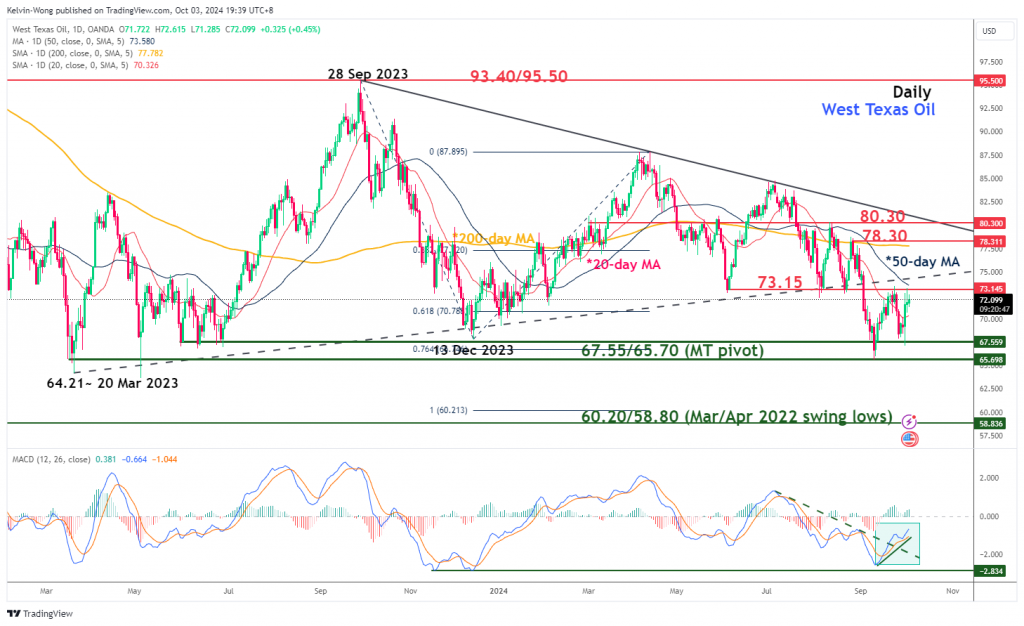- The recent sell-off of 18% in WTI crude oil since August has stalled.
- An increase in hostilities in the Middle East and impending fiscal stimulus measures from China are likely to trigger a medium-term trend change in oil prices.
- Technical factors suggest a further potential rebound in WTI crude oil towards the next medium-term resistance zone at US$78.30/80.30.
This is a follow-up analysis of our prior report “WTI Oil: At the risk of a further drop to retest major range support of US$73.15-71.35/barrel” published on 30 July 2024. Click here for a recap.
In the past two months since the start of August, the price actions of West Texas Oil CFD (a proxy of the WTI crude oil futures) have plummeted more than expected in our prior report, breaching below the US$73.15/barrel level (a major “Symmetrical Triangle” range support from 20 March 20230 low) and tumbled by 18% to print a low of $65.65 on 10 September 2024.
The recent bout of sell-off in oil prices has been attributed to the OPEC+ change in inventory management strategy announced in June, a shift away from targeting US$100/barrel to restore its prior supply cuts by hiking production from September to until late 2025, which would boost oil output by more than 2 million barrels per day, in turn, to negate its declining market share lost to US shale gas producers.
In addition, China’s recent lackluster economic data in the past month ranging from inflation, retail sales, industrial production, manufacturing, and services PMIs have increased the odds of a deflationary spiral unfolding that eventually will reduce oil demand in China, a major consumer of energy products.
Increasing hostilities in the Middle East and China’s impending fiscal stimulus are the game changer
In a desperate attempt to reverse the deflationary spiral in China from being entrenched, China’s top policymakers have shifted gears from piecemeal stimulus measures enacted in the past two years to more forceful accommodating monetary policy (a series of simultaneous rate cuts on its key interest rates and banks’ reverse requirement ratio were announced last week) coupled with clear guidance from September’s Politburo meeting statement that “vowed” to stop the decline in China’s real estate market, a hint that more expansionary fiscal policies are in the pipeline to target consumer spending and confidence directly.
These potential moves by Beijing increased the chances of reflating China’s economy, which will likely boost oil demand as internal demand improves in China.
The second conduit to put a floor in the current spate of oil weakness is via the supply side. Tuesday, 1 October Iran’s missile strike on Israel sparked an increase in hostilities in the Middle East as Israel may consider an option to stage an attack next on Iran’s oil and gas assets as well as its nuclear facilities which can trigger major oil supply disruptions.
MACD trend indicator of WTI crude oil has turned bullish
Fig 1: West Texas Oil CFD medium-term trend as of 3 Oct 2024 (Source: TradingView, click to enlarge chart)
The daily MACD trend indicator of West Texas Oil CFD (a proxy of the WTI crude oil futures) has shaped a higher low on 30 September and staged a bullish breakout from its prior parallel descending resistance in place since 5 July (see Fig 1).
These observations suggest that the bearish momentum of the recent price decline from 5 July to 10 September has been eased; increasing the odds of a trend change at least in the medium-term horizon (multi-week).
Watch the key medium-term pivotal support at US$67.55/65.70, and clearance above the US$73.15 intermediate resistance (also the 50-day moving average) may spark a potential rebound towards the next medium-term resistance zone at US$78.30/80.30 (also the 200-day moving average).
On the flip side, failure to hold at US$67.55/65.70 invalidates the bullish scenario to continue the potential impulsive down move sequence to expose the next medium-term support at US$60.20/58.80.
Content is for general information purposes only. It is not investment advice or a solution to buy or sell securities. Opinions are the authors; not necessarily that of OANDA Business Information & Services, Inc. or any of its affiliates, subsidiaries, officers or directors. If you would like to reproduce or redistribute any of the content found on MarketPulse, an award winning forex, commodities and global indices analysis and news site service produced by OANDA Business Information & Services, Inc., please access the RSS feed or contact us at info@marketpulse.com. Visit https://www.marketpulse.com/ to find out more about the beat of the global markets. © 2023 OANDA Business Information & Services Inc.



